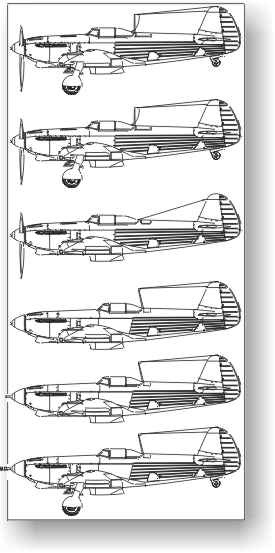
what's new
about us
photalbum
special occasion
kit master
links
This site is a joint
venture of several
air enthusiasts
from Minsk. For some
years we edited and
published the only
aviation magazine
in Belarus - the "AeroPlan".
But
present situation is
such, that we find it
better to carry out our
beloved job
in virtual
space.
The basic difference between serial Yak-9 (first profile) and Yak-7DI was a reduced number of fuel tanks from five to two, providing fuel capacity of 440 l. Started in a series in October 1942, Yak-9 went into combat during Soviet counteroffensive at Stalingrad. After the break in the war flow and start of major offensive operations of the Red Army, the need for a fighter, capable of patrolling the battlefield far from the airfield became ultimate. The decision was already available - the Yak-7DI, more precisely its four-tank wing. In March 1943 a Yak-9D (second profile) version went to series production, featuring four wing fuel tanks and increased oil capacity. Since March 1943 practically all Yak-9 models were produced with 4 tanks for 650 l of fuel. The armament of 20-mm cannon and one heavy machine gun was insufficient under the standards of 1943, especially when fighting bombers getting more and more armor and defensive arms. The works on installation of NS-37 37 mm cannon on Yak-9 frame begun in January 1943, and in March 1943 the new Yak-9T (Tank - fifth profile) had appeared. Increased weight of the armament and strong recoil have required serious alterations in the fuselage design. The cabin was displaced back, but 160 mm of muzzle protruded from the spinner. Ammo capacity comprised 30-32 rounds. The sight often was elementary, of frame type. The handling and flight characteristics of the new aircraft little changed in comparison to lightly armed Yaks, with only vertical maneuverability decreased. As against other Yak-9 versions, Yak-9T had only 2 fuel tanks for 440 l. The light Yak frame appeared insufficiently steady for such powerful gun. After 2-3 shots it dropped the aiming line and lowered a nose, therefore only a good air gunner could successfully use the type. Yak-9T remained in production till the end of the war. At the end of 1943 the attempt was undertaken to equip Yak-9 with even more powerful weapon - 45-mm cannon. New type was developed on a Yak-9T basis, and has received a designation of Yak-9K (sixth profile). 53 machines were manufactured which were tested in field for two month in the autumn 1944 and winter 1945. 51 air combats resulted in 12 enemy fighters downed at loss of one Yak-9K. But unreliable cannon prevented its mass production. Very interesting and rather unexpected was a bomber version Yak-9B (factory designation Yak-9L - third profile). It was developed in February - March 1944 on a basis of Yak-9D. Immediately behind a pilot's seat four pipe-type bomb bays were established, arranged in pairs and inclined 75░ to longitudinal axis of the plane. It was possible to load four 100-kg bombs FAB-100 or four cartridges with anti-tank bombs PTAB, but usually only two forward compartments were loaded. Only a series of 109 machines was manufactured, and they served in 130 iad at the 3rd Byelorussian front. Combat trials of the bomber were recognized unsatisfactory

Yak-9 was a basis for a large variety of models - high-altitude interceptor Jak-9PD, reconnaissance Yak-9R, long-range Yak-9DD, which only slightly differed from base models.
The large variety of models required some unification to be undertaken, which resulted in appearance in May 1944 of Yak-9M model (fourth profile), which allowed manufacturing Yak-9T and Yak-9D around the same fuselage. It differed from standard Yak-9D by the cabin moved 400 mm aft, like on Yak-9T. Besides, the work on elimination of constructive and manufacture defects of the previous models noticed in service was carried out on Yak-9M. Since October 1944 the plane was fitted with VK-105PF2 engine.
In 1944 Yakovlev's design bureau developed a new modification of Yak-9 - the Yak-9U. Actually, it was a new aircraft, very close in arrangement to Yak-3, but with new VK-107 engine. I will return to it in another article.
